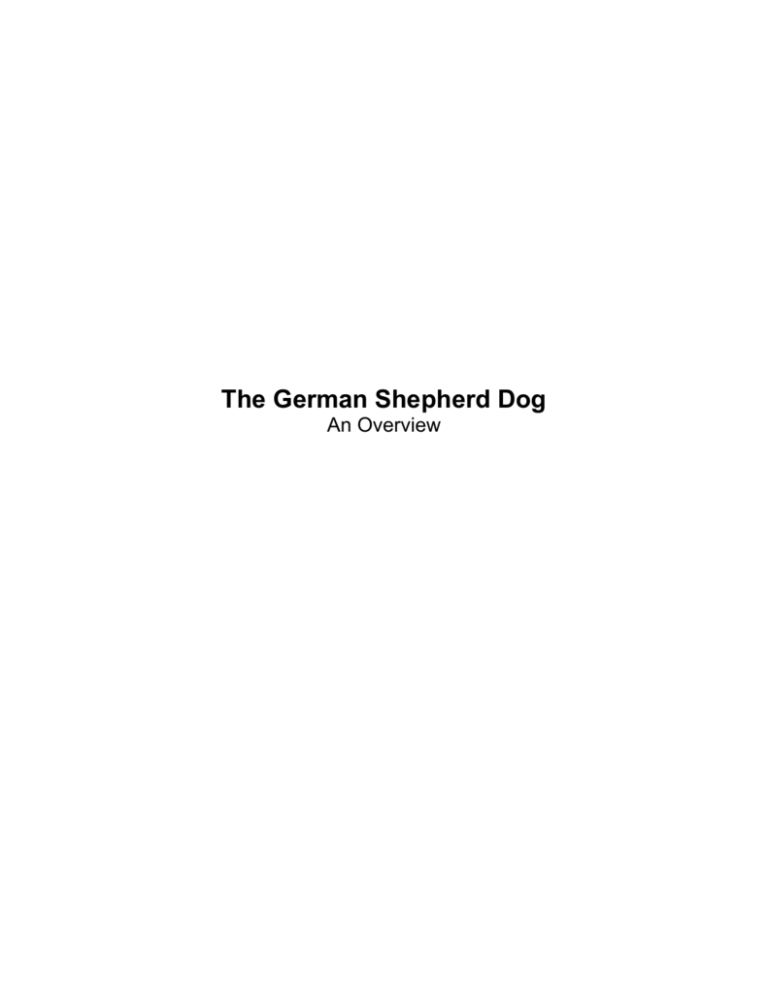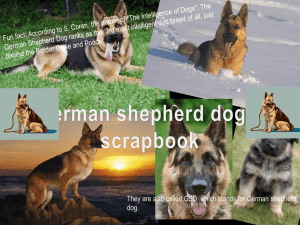German Shepherd dog
advertisement

The German Shepherd Dog An Overview The German Shepherd dog The German Shepherd Dog (GSD) (German:Deutscher Schäferhund) is a breed of large-sized dog that originated in Germany. The German Shepherd is a relatively new breed of dog whose origin dates to 1899. As part of the Herding group, the German Shepherd is a working dog developed originally for herding and guarding sheep. Because of its strength, intelligence and abilities in obedience training it is often employed in police and military roles around the world. History Origins In Europe during the 1800s, attempts were being made to standardize dog breeds. The dogs were bred to preserve traits that assisted in their job of herding sheep and protecting flocks from predators. In Germany this was practised within local communities, where shepherds selected and bred dogs that they believed had traits necessary for herding sheep, such as intelligence, speed, strength, and keen senses of smell. The results were dogs that were able to perform admirably in their task, but that differed significantly, both in appearance and ability, from one locality to another. To combat these differences, the Phylax Society was formed in 1891 with the intention of creating standardised dog breeds in Germany. The society disbanded after only three years due to ongoing internal conflicts regarding the traits in dogs that the society should promote; some members believed dogs should be bred solely for working purposes, while others believed dogs should also be bred for appearance. While unsuccessful in their goal, the Phylax Society had inspired people to pursue standardising dog breeds independently. Max von Stephanitz, an ex-cavalry captain and former student of the Berlin Veterinary College, was one such ex member. He believed strongly that dogs should be bred for working. In 1899, Von Stephanitz was attending a dog show when he was shown a dog named Hektor Linksrhein. Hektor was the product of many generations of selective breeding and completely fulfilled what Von Stephanitz believed a working dog should be. He was pleased with the strength of the dog and was so taken by the animal's intelligence and loyalty, that he purchased him immediately. After purchasing the dog he changed its name to Horand von Grafrath and Von Stephanitz founded the Verein für Deutsche Schäferhunde (Society for the German Shepherd Dog). Horand was declared to be the first German Shepherd Dog and was the first dog added to the society's breed register. Horand became the centre-point of the breeding programs and was bred with dogs belonging to other society members that displayed desirable traits. Although fathering many pups, Horand's most successful was Hektor von Schwaben. Hektor was inbred with another of Horand's offspring and produced Beowulf, who later fathered a total of eighty-four pups, mostly through being inbred with Hektor's other offspring. Beowulf's progeny also were inbred, and it is from these pups that all German Shepherds draw a genetic link. It is believed the society accomplished its goal mostly due to Von Stephanitz's strong, uncompromising leadership and he is therefore credited with being the creator of the German Shepherd Dog. Popularity The breed first gained international recognition at the decline of World War I after returning soldiers spoke highly of the breed, and animal actors Rin Tin Tin and Strongheart popularised the breed further. The first German Shepherd Dog registered in the United States was Queen of Switzerland; however, her offspring suffered from defects as the result of poor breeding, which caused the breed to suffer a decline in popularity during the late 1920s. Popularity increased again after the German Shepherd Sieger Pfeffer von Bern became the 1937 and 1938 Grand Victor in American Kennel club dog shows, only to suffer another decline at the conclusion of World War II, due to anti-German sentiment of the time. As time progressed, their popularity increased gradually until 1993, when they became the third most popular breed in the United States. As of 2009, the breed was the second most popular in the US. Name The breed was named Deutscher Schäferhund by Von Stephanitz, literally translating to "German Shepherd Dog". The breed was so named due to its original purpose of assisting shepherds in herding and protecting sheep. At the time, all other herding dogs in Germany were referred to by this name; thus they became known as Altdeutsche Schäferhunde or Old German Shepherd Dogs. Shepherds were first exported to Britain in 1908, and the UK Kennel Club began to recognise the breed in 1919. The direct translation of the name was adopted for use in the official breed registry; however, at the conclusion of World War I, it was believed that the inclusion of the word "German" would harm the breed's popularity due to the anti-German sentiment of the era. The breed was officially renamed by the UK Kennel Club to "Alsatian Wolf Dog" which was also adopted by many other international kennel clubs. Eventually, the appendage "wolf dog" was dropped. The name Alsatian remained for five decades, until 1977, when successful campaigns by dog enthusiasts pressured the British kennel clubs to allow the breed to be registered again as German Shepherd Dogs. The word "Alsatian" still appeared in parentheses as part of the formal breed name and was only removed in 2010. Description Appearance German Shepherds are a large sized dog, generally between 22 and 26 inchs at the Shoulder and weighing between 49 and 88 pounds. They have a domed forehead, a long square-cut muzzle and a black nose. The jaws are strong, with a scissor-like bite. The eyes are medium-sized and brown with a lively, intelligent, and self-assured look. The ears are large and stand erect, open at the front and parallel, but they often are pulled back during movement. They have a long neck, which is raised when excited and lowered when moving at a fast pace. The tail is bushy and reaches nearly to the ground. German Shepherds can be a variety of colors, the most common of which are the tan/black and red/black varieties. Both varieties have black masks and black body markings which can range from a classic "saddle" to an over-all "blanket." Rarer colour variations include the sable, all-black, all-white, liver, and blue varieties. The all-black and sable varieties are acceptable according to most standards; however, the blue and liver are considered to be serious faults and the all-white is grounds for instant disqualification in some standards. This is because the white coat is more visible, making the dog a poor guard dog, and harder to see in conditions such as snow or when herding sheep. Coat German Shepherds sport a double coat. The outer coat, which is shed all year round, is close and dense with a thick undercoat. The coat is accepted in two variants; medium and long. The long-hair gene is recessive, making the long-hair variety rarer. Treatment of the long-hair variation differs across standards; they are accepted under the German and UK Kennel Clubs but are considered a fault in the American Kennel Club. Intelligence German Shepherds were bred specifically for their intelligence, a trait for which they are now renowned. They are considered to be the third most intelligent breed of dog, following Border Collies and Poodles. In the book The Intelligence of Dogs, author Stanley Coren found that they had the ability to learn simple tasks after only five repetitions and obeyed the first command given 95% of the time. Coupled with their strength, this trait makes the breed desirable as police, guard, and search and rescue dogs, as they are able to quickly learn various tasks and interpret instructions better than other large breeds. Temperament German Shepherds are highly active dogs, and described in breed standards as selfassured. The breed is marked by a willingness to learn and an eagerness to have a purpose. Shepherds have a loyal nature and bond well with people they know, including children. However, they can become over-protective of their family and territory, especially if not socialized correctly. An aloof personality makes them approachable, but not inclined to become immediate friends with strangers. Some handlers think German Shepherds require a "firm hand." But, more recent research into training methods has shown they respond as well, if not better to positive, reward based training methods. Controversy The Kennel Club is currently embroiled in a dispute with German Shepherd breed clubs about the issue of soundness in the show-strain breed. The show-strains have been bred with an extremely sloping back that causes poor gait and disease in the hind legs. Working-pedigree lines, such as those in common use as service dogs, generally retain the traditional straight back of the breed and do not suffer these problems to the same extent. The debate was catalyzed when the issue was raised in the BBC documentary, “Pedigree Dogs Exposed,” which said that critics of the breed describe it as "half dog, half frog". An orthopedic vet remarked on footage of dogs in a show ring that they were "not normal". The Kennel Club's position is that "this issue of soundness is not a simple difference of opinion, it is the fundamental issue of the breed’s essential conformation and movement." The Kennel Club has decided to retrain judges to penalise dogs suffering these problems. In popular culture German Shepherds have been featured in a wide range of media. Strongheart the German Shepherd was one of the earliest canine film stars and was followed by Rin Tin Tin, who is now acclaimed as being the most famous German Shepherd. Both are credited with stars on the Hollywood Walk of Fame. The Littlest Hobo is a Canadian television series, based upon a stray German Shepherd that wanders from town to town, helping people in need. German Shepherds have also played central parts in a number of recent films, including “K-9” (which featured a real police-dog, Koton), “The Hills Have Eyes” and “I Am Legend” (which was played by Renee Calvin's "Ben"). Blondi, Adolf Hitler's German Shepherd, has been featured in a number of documentaries and films about the dictator, such as “Downfall.” The Austrian police drama series “Inspector Rex” centers around a highly intelligent German Shepherd. In Poland, a German Shepherd starred in a '60's hit television series “Czterej Pancerni i Pies,” named Szarik. Batman's dog Ace the Bat-Hound initialy appeared in the Batman comic books, in 1955, through 1964. Between 1964 and 1977, his appearances were sporadic. Another 1970's American TV series prominently featuring a GSD was called "Run, Joe, Run". It was a Saturday morning television program that aired on NBC from 1974 to 1976. Additional Reading Choron, Sandra (2005). Planet Dog: A Doglopedia. Houghton Mifflin Books. ISBN 0618517529. Conan, Michel (2000). The German Shepherd Handbook. Hauppauge, NY: Barron's. ISBN 0764113321. Coren, Stanley (1995). The Intelligence of Dogs: A Guide to the Thoughts, Emotions, and Inner Lives of our Canine Companions. New York: Bantam Books. ISBN 0553374524. Cree, John (1977). Training the Alsatian, the Obedient Companion or Working Partner. Pelham. ISBN 0720709938. Hartnagle-Taylor and Taylor, Jeanne Joy and Ty (2010). Stockdog Savvy. Alpine Publications. ISBN 10:1-57779-106-1 Palika, Liz (2008). Your Happy Healthy Pet: German Shepherd Dog. Wiley. ISBN 0470192313. Rice, Dan (1999). Training Your German Shepherd Dog. Hauppauge, NY: Barron's. ISBN 0764108522. Ross, John; McKinney, Barbara (1996). Puppy Preschool: Raising Your Puppy Right—Right from the Start. St. Martin's Press. ISBN 0312140290. Stevens, Katrina (2002). The German Shepherd Dog. Willow Creek Press. ISBN 1572235128. Strickland, Winifred Gibson; Moses, James A. (1998). The German Shepherd Today. Howell Book House. ISBN 0-87605-154-9. von Stephanitz, Max; Schwabacher, Joseph (1994). The German Shepherd Dog in Word and Picture. Hoflin Publishing Ltd.. ISBN 9789993280057. Willis, Malcolm; Bennett, Janet (1992). The German Shepherd Dog: A Genetic History. Maxwell Macmillan International. ISBN 0876051751. Willis, Malcolm (1976). The German Shepherd Dog: Its History, Development and Genetics. K and R Books. ISBN 0903264153. Fisher, John (1992). Dogwise: The Natural Way to Train Your Dog. Souvenir Press Ltd.. ISBN 0285631144. Hartnagle-Taylor, Jeanne Joy, and Taylor, Ty (2010). Stockdog Savvy. Alpine Publications. ISBN 10:1-57779-106-1.








